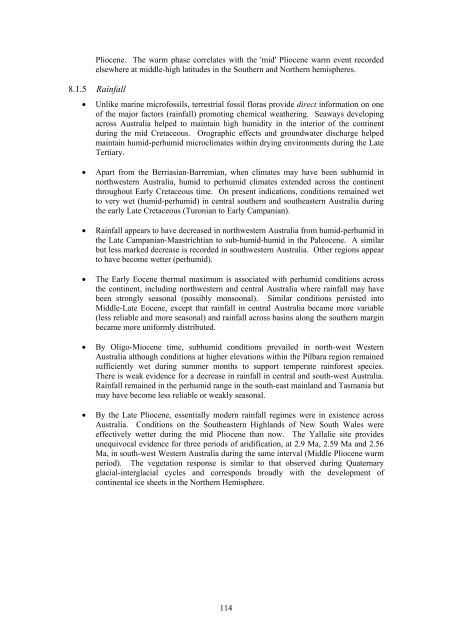OFR 151.pdf - CRC LEME
OFR 151.pdf - CRC LEME
OFR 151.pdf - CRC LEME
Create successful ePaper yourself
Turn your PDF publications into a flip-book with our unique Google optimized e-Paper software.
Pliocene. The warm phase correlates with the 'mid' Pliocene warm event recorded<br />
elsewhere at middle-high latitudes in the Southern and Northern hemispheres.<br />
8.1.5 Rainfall<br />
• Unlike marine microfossils, terrestrial fossil floras provide direct information on one<br />
of the major factors (rainfall) promoting chemical weathering. Seaways developing<br />
across Australia helped to maintain high humidity in the interior of the continent<br />
during the mid Cretaceous. Orographic effects and groundwater discharge helped<br />
maintain humid-perhumid microclimates within drying environments during the Late<br />
Tertiary.<br />
• Apart from the Berriasian-Barremian, when climates may have been subhumid in<br />
northwestern Australia, humid to perhumid climates extended across the continent<br />
throughout Early Cretaceous time. On present indications, conditions remained wet<br />
to very wet (humid-perhumid) in central southern and southeastern Australia during<br />
the early Late Cretaceous (Turonian to Early Campanian).<br />
• Rainfall appears to have decreased in northwestern Australia from humid-perhumid in<br />
the Late Campanian-Maastrichtian to sub-humid-humid in the Paleocene. A similar<br />
but less marked decrease is recorded in southwestern Australia. Other regions appear<br />
to have become wetter (perhumid).<br />
• The Early Eocene thermal maximum is associated with perhumid conditions across<br />
the continent, including northwestern and central Australia where rainfall may have<br />
been strongly seasonal (possibly monsoonal). Similar conditions persisted into<br />
Middle-Late Eocene, except that rainfall in central Australia became more variable<br />
(less reliable and more seasonal) and rainfall across basins along the southern margin<br />
became more uniformly distributed.<br />
• By Oligo-Miocene time, subhumid conditions prevailed in north-west Western<br />
Australia although conditions at higher elevations within the Pilbara region remained<br />
sufficiently wet during summer months to support temperate rainforest species.<br />
There is weak evidence for a decrease in rainfall in central and south-west Australia.<br />
Rainfall remained in the perhumid range in the south-east mainland and Tasmania but<br />
may have become less reliable or weakly seasonal.<br />
• By the Late Pliocene, essentially modern rainfall regimes were in existence across<br />
Australia. Conditions on the Southeastern Highlands of New South Wales were<br />
effectively wetter during the mid Pliocene than now. The Yallalie site provides<br />
unequivocal evidence for three periods of aridification, at 2.9 Ma, 2.59 Ma and 2.56<br />
Ma, in south-west Western Australia during the same interval (Middle Pliocene warm<br />
period). The vegetation response is similar to that observed during Quaternary<br />
glacial-interglacial cycles and corresponds broadly with the development of<br />
continental ice sheets in the Northern Hemisphere.<br />
114

















